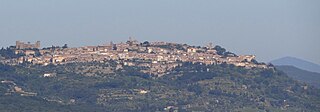
Montalcino is a hill town and comune in the province of Siena, Tuscany, central Italy.

Livorno is a port city on the Ligurian Sea on the western coast of Tuscany, Italy. It is the capital of the Province of Livorno, having a population of 158,493 residents in December 2017. It is traditionally known in English as Leghorn.

Moncalieri is a town and comune of 56,134 inhabitants about 8 kilometres (5 mi) directly south of downtown Turin, in Piedmont, Italy. It is the most populous suburb of Turin and it is notable for its castle, built in the 12th century and enlarged in the 15th century, which later became the favorite residence of King Victor Emmanuel II of Italy and of his daughter Princess Maria Clotilde of Savoy. It is part of the World Heritage Site Residences of the Royal House of Savoy.

Grosseto is a city and comune in the central Italian region of Tuscany, the capital of the Province of Grosseto. The city lies 14 kilometres from the Tyrrhenian Sea, in the Maremma, at the centre of an alluvial plain on the Ombrone river.
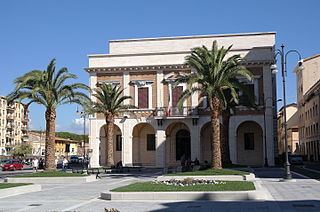
The province of Livorno or, traditionally, province of Leghorn is a province in the Tuscany region of Italy. It includes several islands of the Tuscan Archipelago, including Elba and Capraia. Its capital is the city of Livorno. When formed in 1861, the province included only Livorno and Elba Island. It was extended in 1925 with land from the provinces of Pisa and Genoa. It has an area of 1,211 square kilometres (468 sq mi) and a total population of 343,003 (2012). There are 19 comuni in the province. The coastline of the area is known as "Costa degli Etruschi".
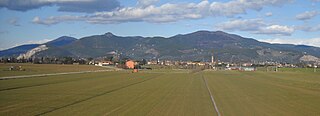
The province of Pisa is a province in the Tuscany region of central Italy. Its capital is the city of Pisa. With an area of 2,448 square kilometres (945 sq mi) and a total population of 421,642, it is the second most populous and fifth largest province of Tuscany. It is subdivided into 37 comuni.

Castiglion Fiorentino is a small, walled city in eastern Tuscany, Italy, in the province of Arezzo, between the cities of Arezzo and Cortona. It is known for its annual festivals and its Etruscan archeological site.

Lanciano is a town and comune in the province of Chieti, part of the Abruzzo region of central Italy. It has 36,304 inhabitants as of 2011. The town is known for the first recorded Catholic Eucharistic Miracle. Lanciano is located about 10 kilometres (6.2 mi) from the Adriatic Sea in an elevated spot.

Giovanni Fattori was an Italian artist, one of the leaders of the group known as the Macchiaioli. He was initially a painter of historical themes and military subjects. In his middle years, inspired by the Barbizon school, he became one of the leading Italian plein-airists, painting landscapes, rural scenes, and scenes of military life. After 1884, he devoted much energy to etching.

Soriano nel Cimino is a town and comune in the province of Viterbo, Lazio, central Italy.

Castagneto Carducci is a comune (municipality) in the Province of Livorno in the Italian region Tuscany, located about 90 kilometres southwest of Florence and about 50 km (31 mi) southeast of Livorno. It is named after the poet Giosuè Carducci, who spent there some years as a child.
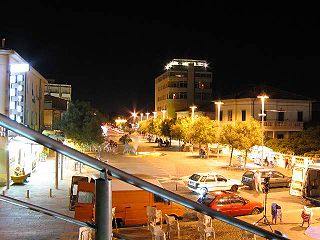
Cecina is a comune (municipality) of 28,322 inhabitants in the Province of Livorno in the Italian region Tuscany, located about 80 kilometres (50 mi) southwest of Florence and about 30 kilometres (19 mi) southeast of Livorno.
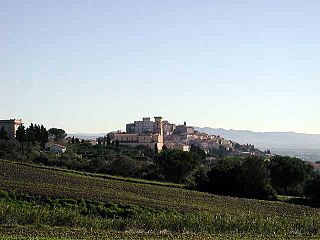
Rosignano Marittimo is a comune (municipality) in the Province of Livorno in the Italian region Tuscany, located about 80 kilometres southwest of Florence and about 20 kilometres (12 mi) southeast of Livorno.

Sassetta is a comune (municipality) in the Province of Livorno in the Italian region Tuscany, located about 90 kilometres southwest of Florence and about 50 kilometres (31 mi) southeast of Livorno.

Tuscany is a region in central Italy with an area of about 23,000 square kilometres and a population of about 3.8 million inhabitants. The regional capital is Florence (Firenze).

Giglio Porto is a village in Tuscany, central Italy, administratively a frazione of the comune of Isola del Giglio, province of Grosseto. As of 2021, its population amounted to 750.

Castiglioncello Bandini is a village in Tuscany, central Italy, administratively a frazione of the comune of Cinigiano, province of Grosseto. At the time of the 2001 census its population amounted to 93.

Porrona is a village in Tuscany, central Italy, administratively a frazione of the comune of Cinigiano, province of Grosseto. At the time of the 2001 census its population amounted to 24.
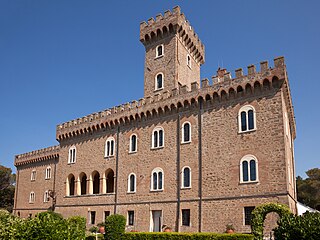
The Pasquini Castle stands in Castiglioncello, in the Comune of Rosignano Marittimo, near the railway station.

Azienda Trasporti Livornese, known as ATL, was a public company that managed the local public transport in Livorno and its province including Elba.



























